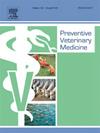Comparing expert stakeholders’ assessments of the relative impact of management practices on dairy calf welfare using best-worst scaling
IF 2.4
2区 农林科学
Q1 VETERINARY SCIENCES
引用次数: 0
Abstract
The UK dairy industry is under increasing public scrutiny, with growing intensification sparking concerns for farm animal health and welfare. Despite established best practices, achieving optimal calf health and welfare remains an industry-wide challenge. Research into calf health and welfare is advancing; however, it remains unclear how management practices impact welfare relative to one another. This study aimed to establish a ranking of practices according to their relative impact on dairy calf welfare using expert consensus, as well as examine variations in stakeholder perceptions. Maximum Difference Scaling, a discrete choice methodology offering greater discrimination between items than traditional ranking methods, was used. Responses were received from 55 veterinarians, 44 farmers and 43 agricultural representatives in the United Kingdom. Veterinarians and agricultural representatives ranked no pain mitigation during painful procedures as most severe, whilst farmers ranked suboptimal colostrum as most severe. Open bucket milk feeding was ranked as least severe by veterinarians, immediate cow-calf separation was ranked lowest by farmers, and age-based weaning was ranked lowest by agricultural representatives. Greater alignment in opinion was observed between veterinarians and agricultural representatives, possibly reflecting their shared role as an advisor on farms. The rankings achieved will facilitate the prioritisation of on-farm resources and guide education efforts towards practices with greater influences on welfare. Understanding the variation in stakeholder perceptions also provides an opportunity to strengthen advisor-farmer relationships and communication when addressing welfare challenges.
比较专家利益相关者对管理实践对奶牛小牛福利的相对影响的评估,使用最佳-最差尺度
英国乳制品行业正受到越来越多的公众监督,越来越严格的监督引发了人们对农场动物健康和福利的担忧。尽管建立了最佳实践,但实现最佳小牛健康和福利仍然是整个行业面临的挑战。犊牛健康福利研究不断推进;然而,目前还不清楚管理实践是如何影响福利的。本研究旨在利用专家共识根据其对奶牛小牛福利的相对影响建立实践排名,并检查利益相关者看法的变化。最大差异尺度,一个离散的选择方法提供更大的区分项目之间比传统的排序方法,被使用。我们收到了来自英国55名兽医、44名农民和43名农业代表的答复。兽医和农业代表认为在痛苦的过程中没有减轻疼痛是最严重的,而农民认为不理想的初乳是最严重的。兽医认为开桶奶喂养是最不严重的,农民认为立即分离小牛是最低的,农业代表认为按年龄断奶是最低的。兽医和农业代表之间的意见更加一致,这可能反映了他们作为农场顾问的共同角色。所取得的排名将有助于确定农场资源的优先次序,并将教育工作引向对福利有更大影响的做法。了解利益相关者观念的变化也为在应对福利挑战时加强顾问与农民的关系和沟通提供了机会。
本文章由计算机程序翻译,如有差异,请以英文原文为准。
求助全文
约1分钟内获得全文
求助全文
来源期刊

Preventive veterinary medicine
农林科学-兽医学
CiteScore
5.60
自引率
7.70%
发文量
184
审稿时长
3 months
期刊介绍:
Preventive Veterinary Medicine is one of the leading international resources for scientific reports on animal health programs and preventive veterinary medicine. The journal follows the guidelines for standardizing and strengthening the reporting of biomedical research which are available from the CONSORT, MOOSE, PRISMA, REFLECT, STARD, and STROBE statements. The journal focuses on:
Epidemiology of health events relevant to domestic and wild animals;
Economic impacts of epidemic and endemic animal and zoonotic diseases;
Latest methods and approaches in veterinary epidemiology;
Disease and infection control or eradication measures;
The "One Health" concept and the relationships between veterinary medicine, human health, animal-production systems, and the environment;
Development of new techniques in surveillance systems and diagnosis;
Evaluation and control of diseases in animal populations.
 求助内容:
求助内容: 应助结果提醒方式:
应助结果提醒方式:


